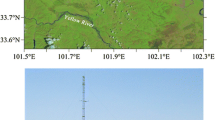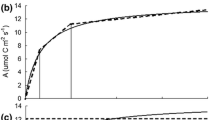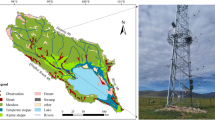Abstract
Photosynthesis is a very important sub-process in the carbon cycle and is a crucial sub-modular function in carbon cycle models. In this study, two typical photosynthesis parameterization schemes were compared based on meteorological and eddy covariance (EC) observations at an alpine meadow site. The photosynthesis model parameters were estimated using the Markov Chain Monte Carlo (MCMC) method. The results indicated that the Farquhar-conductance coupled model better predicted the gross primary production (GPP) for the alpine meadow ecosystem at an hourly time scale than the light use efficiency (LUE) model even though the Farquhar-conductance coupled model has a lower computational efficiency than the LUE model. Compared to the Ball–Woodrow–Berry (BWB) stomatal conductance model, coupling the Farquhar model with the Leuning stomatal conductance model more accurately simulated GPP.














Similar content being viewed by others
References
Anderson MC, Norman JM, Meyers TP, Diak GR (2000) An analytical model for estimating canopy transpiration and carbon assimilation fluxes based on canopy light-use efficiency. Agric For Meteorol 101:265–289
Ball JT, Woodrow IE, Berry JA (1987) A model predicting stomatal conductance and its contribution to the control of photosynthesis under different environmental conditions. In: Biggens J (ed) Progress in Photosynthesis Research, vol.IV. Martinus-Nijhoff Publishers, Dordrecht, The Netherlands, pp. 221–224
Cowan I (1978) Stomatal behaviour and environment. Adv Bot Res 4:117–228
Drolet G, Middleton E, Huemmrich K, Hall F, Amiro B, Barr A, Black T, McCaughey J, Margolis H (2008) Regional mapping of gross light-use efficiency using MODIS spectral indices. Remote Sens Environ 112:3064–3078
Farquhar GD, von Caemmerer S, Berry JA (2001) Models of photosynthesis. Plant Physiol 125:42–45
Farquhar GD, von Caemmerer S, Berry JA (1980) A biochemical model of photosynthetic CO2 assimilation in leaves of C3 species. Planta 149:78–90
Gelman A., Rubin D.B. (1992). Inference from iterative simulation using multiple sequences. Stat Sci 457-472
Hastings WK (1970) Monte Carlo Sampling methods using Markov chains and their applications. Biometrika 57:97–109
Janzen HH (2004) Carbon cycling in earth systems—a soil science perspective. Agric Ecosyst Environ 104:399–417
Keenan TF, Carbone MS, Reichstein M, Richardson AD (2011) The model-data fusion pitfall: assuming certainty in an uncertain world. Oecologia 167:587–597
Kim SH, Lieth JH (2003) A coupled model of photosynthesis, stomatal conductance and transpiration for a rose leaf (Rosa hybrida L.). Ann Bot 91:771–781
Knorr W, Kattge J (2005) Inversion of terrestrial ecosystem model parameter values against eddy covariance measurements by Monte Carlo sampling. Glob Chang Biol 11:1333–1351
Kosugi Y, Shibata S, Kobashi S (2003) Parameterization of the CO2 and H2O gas exchange of several temperate deciduous broad-leaved trees at the leaf scale considering seasonal changes. Plant Cell Environ 26:285–301
Leuning R (1995) A critical appraisal of a combined stomatal-photosynthesis model for C3 plants. Plant Cell Environ 18:339–355
Li H, Xie Y, Ma M (2009a) Reconstruction of temporal NDVI dataset: evaluation and case study. Remote Sensing Technology and Application 5:18–25
Li X., Li X., Li Z., Ma M., Wang J., Xiao Q., Liu Q., Che T., Chen E., Yan G. (2009b). Watershed allied telemetry experimental research. J Geophys Res 114(D22103). doi:10.1029/2008JD011590
Luo Y, White LW, Canadell JG, DeLucia EH, Ellsworth DS, Finzi A, Lichter J, Schlesinger WH (2003) Sustainability of terrestrial carbon sequestration: a case study in Duke Forest with inversion approach. Glob Biogeochem Cycles 17:1–21
Ma M, Veroustraete F (2006) Reconstructing pathfinder AVHRR land NDVI time-series data for the Northwest of China. Adv Space Res 37:835–840
McCallum I, Franklin O, Moltchanova E, Merbold L, Schmullius C, Shvidenko A, Schepaschenko D, Fritz S (2013) Improved light and temperature responses for light use efficiency based GPP models. Biogeosci Discuss 10:8919–8947
Metropolis N, Rosenbluth AW, Rosenbluth MN, Teller AH, Teller E (1953) Equation of state calculations by fast computing machines. J Chem Phys 21:1087
Moorcroft P, Hurtt G, Pacala SW (2001) A method for scaling vegetation dynamics: the ecosystem demography model (ED). Ecol Monogr 71:557–586
Mosegaard K, Sambridge M (2002) Monte Carlo analysis of inverse problems. Inverse Probl 18:R29
Ruimy A, Kergoat L, Bondeau A (1999) Comparing global models of terrestrial net primary productivity (NPP): analysis of differences in light absorption and light-use efficiency. Glob Chang Biol 5:56–64
Running S.W., Nemani R., Glassy J.M., Thornton P.E. (1999). MODIS daily photosynthesis (PSN) and annual net primary production (NPP) product (MOD17) Algorithm Theoretical Basis Document. University of Montana, SCF At-Launch Algorithm ATBD Documents (available online at: www. ntsg. umt. edu/modis/ATBD/ATBD_MOD17_v21. pdf)
Sellers P, Berry J, Collatz G, Field C, Hall F (1992) Canopy reflectance, photosynthesis, and transpiration. III. A reanalysis using improved leaf models and a new canopy integration scheme. Remote Sens Environ 42:187–216
Singsaas EL, Ort DR, DeLucia EH (2001) Variation in measured values of photosynthetic quantum yield in ecophysiological studies. Oecologia 128:15–23
Sitch S, Smith B, Prentice IC, Arneth A, Bondeau A, Cramer W, Kaplan JO, Levis S, Lucht W, Sykes MT, Thonicke K, Venevsky S (2003) Evaluation of ecosystem dynamics, plant geography and terrestrial carbon cycling in the LPJ dynamic global vegetation model. Glob Chang Biol 9:161–185
Thornton P, Law B, Gholz HL, Clark KL, Falge E, Ellsworth D, Goldstein A, Monson R, Hollinger D, Falk M (2002) Modeling and measuring the effects of disturbance history and climate on carbon and water budgets in evergreen needleleaf forests. Agric For Meteorol 113:185–222
Tuzet A, Perrier A, Leuning R (2003) A coupled model of stomatal conductance, photosynthesis and transpiration. Plant Cell Environ 26:1097–1116
Van Wijk M, Dekker S, Bouten W, Bosveld F, Kohsiek W, Kramer K, Mohren G (2000) Modeling daily gas exchange of a Douglas-fir forest: comparison of three stomatal conductance models with and without a soil water stress function. Tree Physiol 20:115–122
Veroustraete F, Sabbe H, Eerens H (2002) Estimation of carbon mass fluxes over Europe using the C-Fix model and Euroflux data. Remote Sens Environ 83:376–399
Wang X, Ma M, Huang G, Veroustraete F, Zhang Z, Song Y, Tan J (2012) Vegetation primary production estimation at maize and alpine meadow over the Heihe River Basin, China. Int J Appl Earth Obs Geoinfo 17:94–101
Wang YP, Trudinger CM, Enting IG (2009) A review of applications of model–data fusion to studies of terrestrial carbon fluxes at different scales. Agric For Meteorol 149:1829–1842
Wu X, Luo Y, Weng E, White L, Ma Y, Zhou X (2009) Conditional inversion to estimate parameters from eddy-flux observations. J Plant Ecol 2:55–68
Xiao X, Zhang Q, Braswell B, Urbanski S, Boles S, Wofsy S, Moore III B, Ojima D (2004a) Modeling gross primary production of temperate deciduous broadleaf forest using satellite images and climate data. Remote Sens Environ 91:256–270
Xiao XM, Hollinger D, Aber J, Goltz M, Davidson EA, Zhang QY, Moore III B (2004b) Satellite-based modeling of gross primary production in an evergreen needleleaf forest. Remote Sens Environ 89:519–534
Xu T, White L, Hui D, Luo Y (2006) Probabilistic inversion of a terrestrial ecosystem model: analysis of uncertainty in parameter estimation and model prediction. Glob Biogeochem Cycles 20:2. doi:10.1029/2005GB002468
Yuan WP, Liu SG, Zhou GS, Zhou GY, Tieszen LL, Baldocchi D, Bernhofer C, Gholz H, Goldstein AH, Goulden ML, Hollinger DY, Hu Y, Law BE, Stoy PC, Vesala T, Wofsy SC (2007) Deriving a light use efficiency model from eddy covariance flux data for predicting daily gross primary production across biomes. Agric For Meteorol 143(3):189–207
Zhu G-F, Li X, Su Y-H, Lu L, Huang C-L (2011) Seasonal fluctuations and temperature dependence in photosynthetic parameters and stomatal conductance at the leaf scale of Populus euphratica Oliv. Tree Physiol 31:178–195
Zhu G, Li X, Su Y, Huang C (2010) Parameterization of a coupled CO 2 and H 2 O gas exchange model at the leaf scale of Populus euphratica. Hydrol Earth Syst Sci 14:419–431
Acknowledgments
This work was supported by the National Natural Science Foundation of China (Grant No. 91225302), the Chinese State Key Basic Research Project (Grant No. 2013CB956604), the National Natural Science Foundation of China (Grant No. 41301362 and 41201372) and the “Watershed Allied Telemetry Experimental Research (WATER)” experiment. We also would like to thank the Editor and anonymous reviewers for their constructive comments on this manuscript.
Author information
Authors and Affiliations
Corresponding author
Appendix A: photosynthesis model
Appendix A: photosynthesis model
1.1 Appendix A.1: Scalars in LUE model
f(T) is calculated using the following equation (Xiao et al. 2004b):
where T max [°C], T min [°C], and T opt [°C] are the maximum, minimum, and optimal photosynthetic temperatures, respectively. Moreover, T [°C] is the air temperature; f(T) [dimensionless] was set to 0 when T was less than T min or T was greater than Tmax. Furthermore, f(VPD) is calculated using the following equation (Running et al. 1999):
VPDmax [Pa] and VPDmin [Pa] are empirical parameters, and VPD [Pa] is the vapor pressure deficit, which is calculated using the air temperature T [°C] and RH [%] (Wu et al. 2009):
Furthermore, fAPAR is calculated with an exponential model using the LAI as input (Ruimy et al. 1999):
where kn is the light extinction coefficient and LAI is leaf area index.
1.2 Appendix A.2: Ac and Ae in Farquhar model
Ac [μmol CO2/m2/s] is calculated according to the following equation:
where C i is the intercellular CO2 concentration [μmol CO2/mol], C a is the ambient CO2 concentration [365 μmol CO2/mol], and fc i is the ratio of the intercellular CO2 concentration to the ambient air CO2 concentration. Moreover, O x is the oxygen concentration in the air [0.21 mol O2/mol], and V m is the maximum carboxylation rate [μmol CO2/m2/s], which is calculated using the canopy temperature T [°C] and activation energy E vm according to the Arrhenius equation:
where \( {V}_m^{25} \) is the maximum carboxylation rate at 25 °C and R is the universal gas constant [8.314 J/K/mol]. The CO2 compensation point without dark respiration is represented by Γ * [μmol CO2/mol] and is also calculated using the Arrhenius equation:
where \( {\varGamma}_{*}^{25} \) is the CO2 compensation point without dark respiration at 25 °C; \( {E}_{\varGamma_{*}^{25}} \) describes the temperature dependence ofΓ *. Two Michaelis–Menten constants are temperature dependent based on the Arrhenius equation, similarly to V m .K c is the Michaelis–Menten constant for carboxylation [μmol/mol] and is calculated using the following equation:
where \( {E}_{K_c} \) is the activation energy and \( {K}_c^{25} \) is the Michaelis–Menten constant for carboxylation at 25 °C. Moreover, K o is the Michaelis–Menten constant for oxygenation (mol/mol) and is calculated according to the following relationship:
where \( {E}_{K_o} \) is the activation energy and \( {K}_o^{25} \) is the Michaelis–Menten constant for oxygenation at 25 °C. The light electron transport-limited CO2 assimilation rate, Ae [μmol CO2/m2/s], is calculated as follows:
where I is the absorbed PAR [μmol photons/m2/s], α q is the quantum efficiency of photon capture [mol/mol photons], and J m is the maximum electron transport rate [μmol CO2/m2/s]. Furthermore, Jm depends on temperature and is calculated by
where r JmVm is the ratio of Jm to \( {V}_m^{25} \) at 25 °C; E Jm is the activation energy.
Rights and permissions
About this article
Cite this article
Wang, X., Cheng, G., Li, X. et al. A comparison of two photosynthesis parameterization schemes for an alpine meadow site on the Qinghai-Tibetan Plateau. Theor Appl Climatol 126, 751–764 (2016). https://doi.org/10.1007/s00704-015-1611-y
Received:
Accepted:
Published:
Issue Date:
DOI: https://doi.org/10.1007/s00704-015-1611-y




